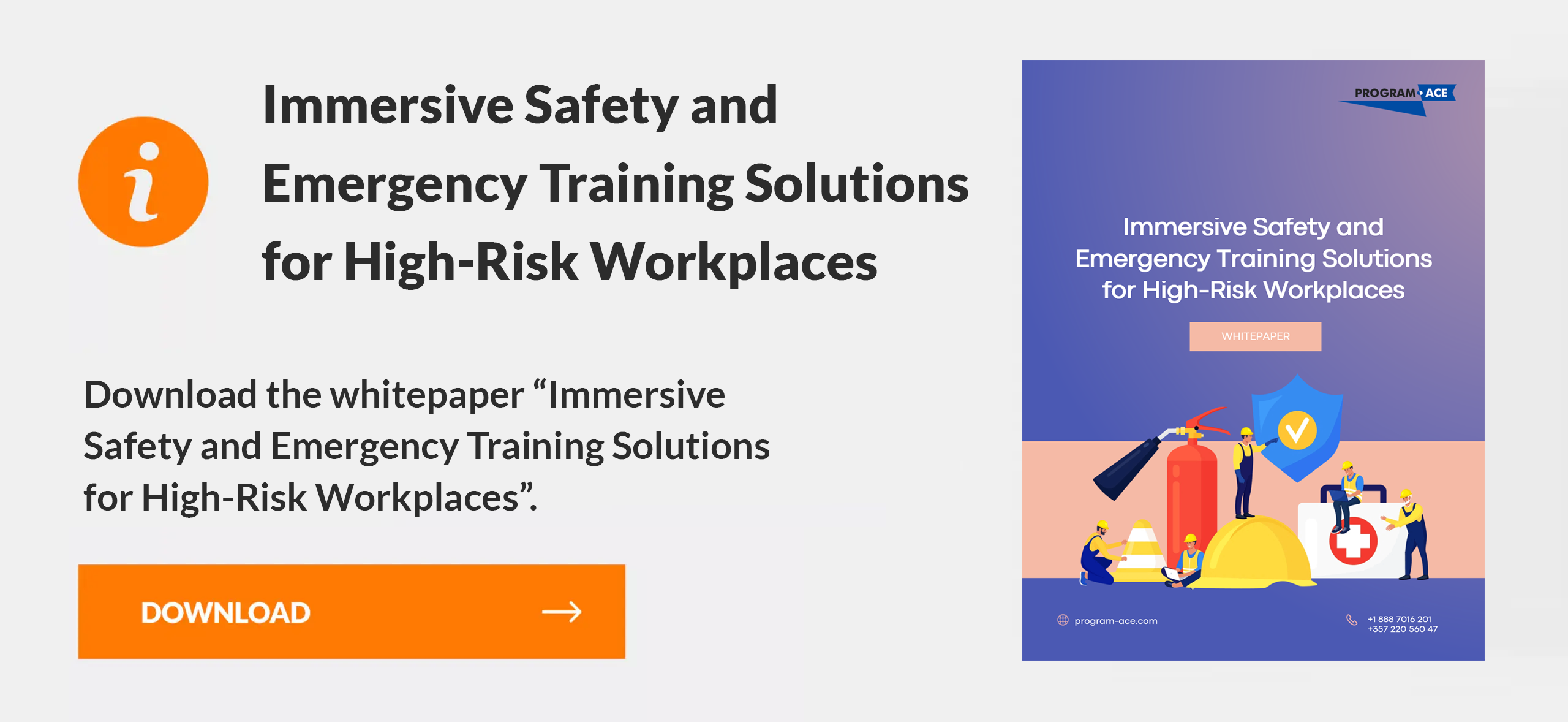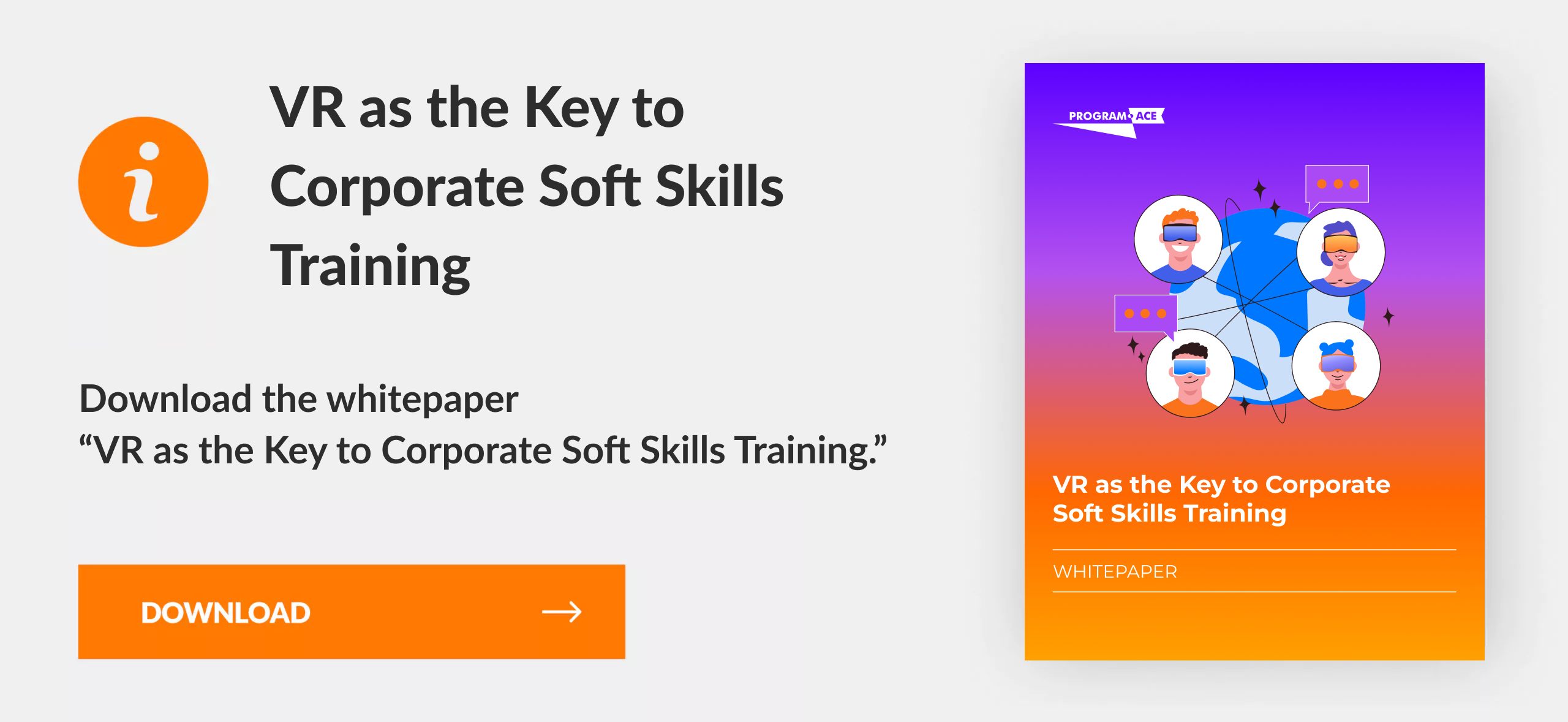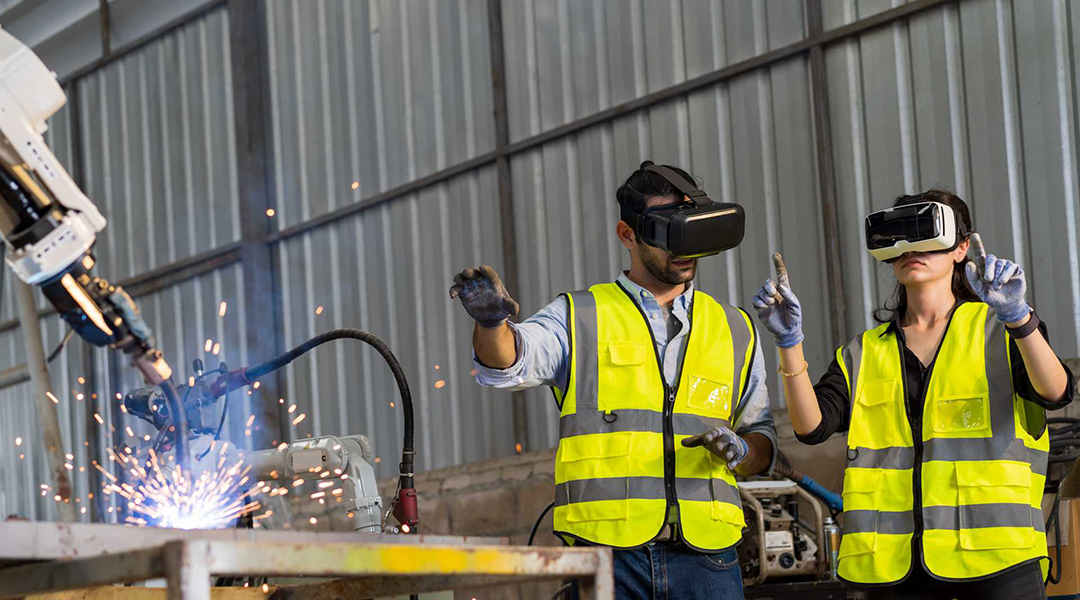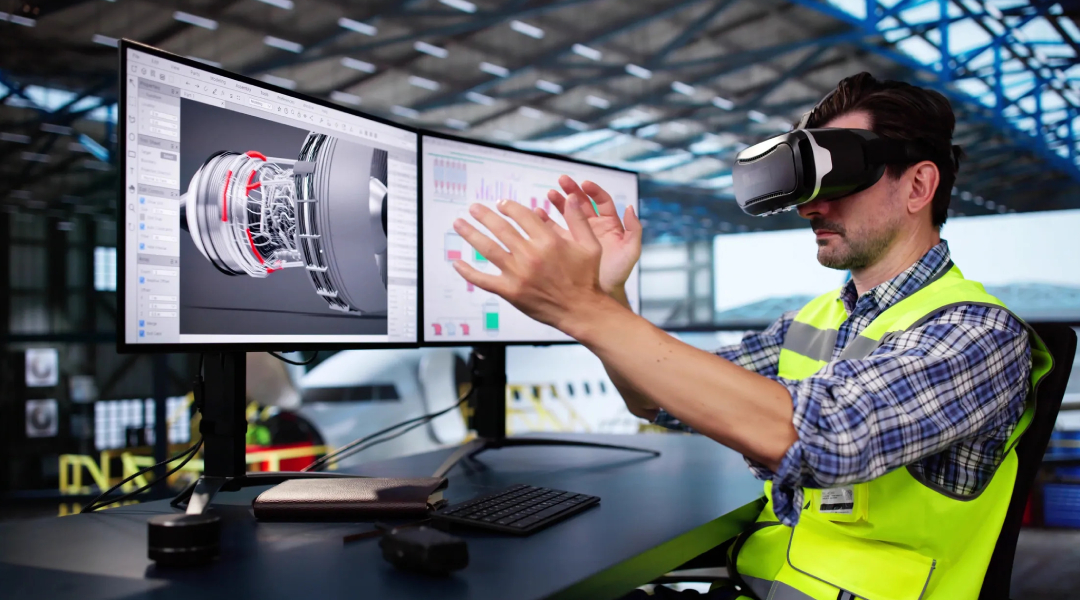Virtual reality has become a vital asset for employee development in diverse sectors. Its utilization in training has demonstrated remarkable effectiveness, rendering learning more immersive, economically viable, and temporally efficient. Integrating VR training solutions into your organizational framework requires careful planning and execution. Organizations should define their training objectives, choose the proper hardware and software, design engaging training content, and provide adequate support and training for learners.
By embracing VR technology, organizations can stay ahead of the curve and empower their employees with cutting-edge training experiences. This article aims to furnish insight into VR training solutions by showing their advantages, presenting instances of VR training modules, and offering guidance on integrating VR training solutions into your organizational framework. Delve deeper to uncover the myriad benefits of virtual training solutions.
What Is Virtual Reality Training, and Why Do You Need It?

Virtual reality training involves using VR technology to deliver educational content or training materials, rather than traditional classroom settings. This method immerses participants in a three-dimensional environment where they can interact with virtual elements in real-time. Training can be conducted synchronously, with all participants experiencing and interacting within the same virtual space simultaneously, providing a highly engaging and interactive learning experience that goes beyond standard video conferencing or online meeting rooms.
Virtual reality training solutions can be asynchronous, allowing individuals to progress through the material at their own pace and convenience within specified time limits. From online workshops and tutorials to interactive demonstrations and skills assessments, virtual reality training offers a versatile approach to educating users on various topics. This flexibility enables customization to suit different learning needs and target specific niches effectively. Why choose VR training? Implementing this training strategy offers numerous benefits for instructors and learners.
Advantages of VR training:
Comprehensive learning. VR training empowers instructors to customize the delivery of educational content and development programs. By establishing a virtual learning environment, educators can curate content for a more coherent and extensive learning experience, aiding students in acquiring essential skills.
Enhanced accessibility. Virtual reality training enhances accessibility by eliminating the need for learners to attend in-person workshops or seminars. Enabling users to access training remotely from their homes eliminates geographical barriers, facilitating broader participation.
Flexible scheduling. With this type of training, learners can study at their own pace and convenience. This flexibility accommodates individuals' diverse schedules, enabling them to engage with training materials at times that suit them best.
Increased engagement. VR training tools often include interactive features such as polls, quizzes, and Q&A sessions, fostering greater engagement with educational content. These interactive elements allow instructors to assess students' comprehension and adapt their teaching approach accordingly.
Improved efficiency. Virtual reality training sessions promote efficiency and productivity by effectively capturing and reusing learning materials. By recording sessions, instructors can repurpose content for future training endeavors, optimizing time and resources.
Limitations of Virtual Reality Training
Despite its advantages, VR training may present some challenges that warrant consideration:
Engagement difficulties. Maintaining student engagement can be more challenging in virtual settings, as learners may face distractions within their home environments. Instructors may need to employ additional strategies to encourage active participation.
Technological barriers. Virtual reality training requires a basic understanding of technology, which may pose challenges for instructors and learners. Technical issues and troubleshooting may arise during sessions, impacting the learning experience.
Catering to diverse learners. This approach to training may present challenges in catering to the needs of all learners, particularly in large group settings. Scheduling meetings across multiple time zones and fostering interpersonal relationships without in-person interaction can be daunting.
Overall, while virtual reality training solutions offer numerous benefits, instructors should remain mindful of their limitations and employ strategies to mitigate potential challenges for optimal learning outcomes.
Types of VR Training Solutions

Selecting the appropriate VR training solution requires an understanding of the different types of platforms available in the market. Each platform serves unique functions and is designed with specific training objectives in mind.
Presentation platforms. These are typically used for delivering information in a unidirectional manner. While effective for straightforward information dissemination, they lack the interactivity required for more engaging training experiences.
Virtual meeting platforms. These platforms are excellent for fostering communication and collaboration among geographically dispersed teams. However, they often fall short in providing structured learning environments specifically tailored for training purposes.
For a truly effective VR training solution, choosing platforms specifically designed for immersive learning is crucial. These specialized VR training platforms allow for:
- real-time interaction and feedback;
- simulation of complex scenarios without real-world risks;
- engagement in realistic tasks to enhance learning and retention;
- customization to fit specific training needs and outcomes.
Understanding the key features and capabilities of each type of VR platform helps in crafting a training solution that is not only immersive but also aligned with the specific learning goals and objectives of an organization.
Interactive Virtual Reality Training Platforms
The popularity of presentation platforms has surged alongside the increasing demand for webcasts. While these platforms prove useful for broadcast-oriented communication, their one-way format constricts them and offers limited interaction capabilities. This virtual reality training type takes engagement to another level by integrating various collaborative practices into live online training sessions. This approach typically results in high levels of engagement and is known for its effectiveness in achieving better results and higher rates of student knowledge retention.
Simulation-Based Training Solutions
This virtual meeting platform is tailored for teams dispersed across the globe, enabling them to convene in a virtual space and interact seamlessly. These platforms facilitate collaboration, brainstorming sessions, and the creation of action items among team members. They offer fundamental features like video conferencing, presentation screen sharing, and social interaction tools like chat functionalities.
Video-Based Learning
The next category of virtual reality training comprises pre-recorded courses commonly known as video-based learning. These courses can be part of microlearning or nanolearning, and more elaborate training programs can be delivered as off-the-shelf course content. Video-based learning offers the advantage of generating passive income, making it a lucrative option for online training. You can create comprehensive courses with supplementary materials and videos that elucidate vital concepts. While creating these videos entails investing time in writing scripts, recording, and editing, the payoff lies in the ability to resell them. With the right marketing strategies, you can generate income from these courses while pursuing other endeavors.
Benefits of Virtual Reality Training Solutions for Business
Implementing Effective Virtual Reality Training Techniques: 5 Case Studies
VR technologies provide immersive and interactive learning experiences by simulating real-world scenarios. This bridges the gap between theoretical knowledge and practical application in various fields such as healthcare, aviation, and customer service. VR training offers a unique opportunity to enrich traditional training methods with engaging and lifelike virtual reality simulations.
Healthcare advancements
Virtual reality solutions have revolutionized medical training, offering unprecedented opportunities for healthcare professionals. Surgeons can now practice complex procedures and diagnostic techniques in a risk-free virtual environment, improving skills and reducing errors.
Program-Ace developed a VR healthcare app for hand rehabilitation on the Oculus (Meta) Quest platform, featuring a headset and VR gloves. Users follow a virtual trainer named Andy to complete hand movement objectives, aiming to improve mobility, range of motion, and strength. Key challenges included ensuring the solution's medical impact, implementing a high-accuracy tracking system, and creating a realistic simulation. The project required extensive research and precise motion tracking. Despite tight deadlines, the app successfully provided an immersive rehabilitation experience with 3D models, animation, sound, and VFX, benefiting patients and medical professionals in telemedicine.
Enhanced emergency response training
Training saves lives in critical fields such as safety and emergency response. VR technologies have emerged as valuable tools, allowing trainees to simulate emergency scenarios realistically. By practicing response strategies in virtual environments, individuals can enhance their decision-making skills and prepare for high-pressure situations without exposing themselves to real-world risks.
For instance, police departments in Fort Myers, Florida, and Sacramento, California, are integrating virtual reality training to enhance officers' capabilities in addressing critical challenges. In Fort Myers, VR simulations immerse officers in life-threatening situations, such as encounters with individuals facing mental health issues or addiction. The goal is to practice de-escalation techniques effectively and prevent escalation. Similarly, the Sacramento Police Department utilizes VR to confront implicit biases among officers, exposing them to scenarios involving individuals with diverse backgrounds to improve responses and foster understanding.
Industrial training innovations
The manufacturing and industrial sectors frequently deal with intricate machinery and potentially dangerous equipment. Conventional training approaches may fail to equip workers for on-site challenges adequately. Nevertheless, VR platforms have transformed training within these industries by offering lifelike scenarios for machinery operations.
Consequently, the risk of on-site accidents is mitigated, while productivity and efficiency see notable improvements. Consider a factory worker who can now engage with virtual machinery, troubleshoot potential issues, and acquaint themselves with processes before handling actual equipment. This immersive learning experience fosters a more proficient and self-assured workforce.
Soft skills development
Customer service is a fundamental pillar for numerous businesses, as the caliber of customer interactions can significantly impact a company’s reputation. Likewise, soft skills like communication, problem-solving, and empathy are pivotal for fostering positive work environments and enhancing team dynamics.
VR tools have emerged to facilitate soft skills training by replicating customer interactions in virtual environments. This allows employees to practice navigating various scenarios and challenging situations. Through virtual reality training, employees can enhance their empathy, communication skills, and problem-solving abilities, leading to heightened customer satisfaction and improved employee performance.
Automotive sector transformations
VR technologies are revolutionizing the automotive sector, introducing significant transformations across various areas. VR training enhances assembly efficiency and reduces errors by providing immersive training experiences. VR further enhances customer experiences by enabling the visualization of vehicles in different configurations and assisting technicians in maintenance and repair tasks with interactive guides. Overall, VR technologies drive productivity, cost reduction, and enhanced customer satisfaction within the automotive industry.
Mixed reality allows swift visualization of vehicle functions and new interior concepts, providing developers with flexibility and insights into design elements. Audi leverages VR for training to minimize errors in complex systems, offering custom training courses through a software development kit. Similarly, Volkswagen employs VR for convenient, location-independent training, enabling employees to perform tasks as if on-site and facilitating remote meetings with geographically dispersed participants.
Want to know more about how to implement VR training?
Selecting the Right Platform for Your Business Requirements
Selecting the right platform ensures practical and engaging virtual reality training sessions. While most VR training platforms offer similar basic features like screen sharing and chat, there are vital factors to consider when making your choice:
Engagement
Determine if your training will be presentation-focused or require interactive experiences like group work and annotation. Look for features such as chat, file sharing, and breakout options that enhance audience engagement and participation.
Integration
Assess how seamlessly the platform integrates with your existing systems, particularly your learning management system. Consider your team's technical expertise and whether they have the resources to support the platform's deployment and ongoing maintenance.
Technology
Evaluate your organization's technological capabilities and the comfort level of facilitators and participants with the platform. Ensure that the platform is compatible with the devices (computers or mobile) that participants will be using to access virtual classrooms.
Alignment with Organizational Needs
Choose a platform that aligns with your organization's learning objectives and goals. Consider factors such as the need for small group interactions, mobile accessibility, and consistency in training delivery across multiple facilitators.
Ease of Use
Select a platform that is intuitive and user-friendly for both trainers and participants. Minimize the learning curve to ensure smooth access and usability without extensive troubleshooting. By prioritizing these factors, you can select a virtual reality training solution that meets your organization's unique needs and facilitates compelling learning experiences.
The Future Outlook of VR Training
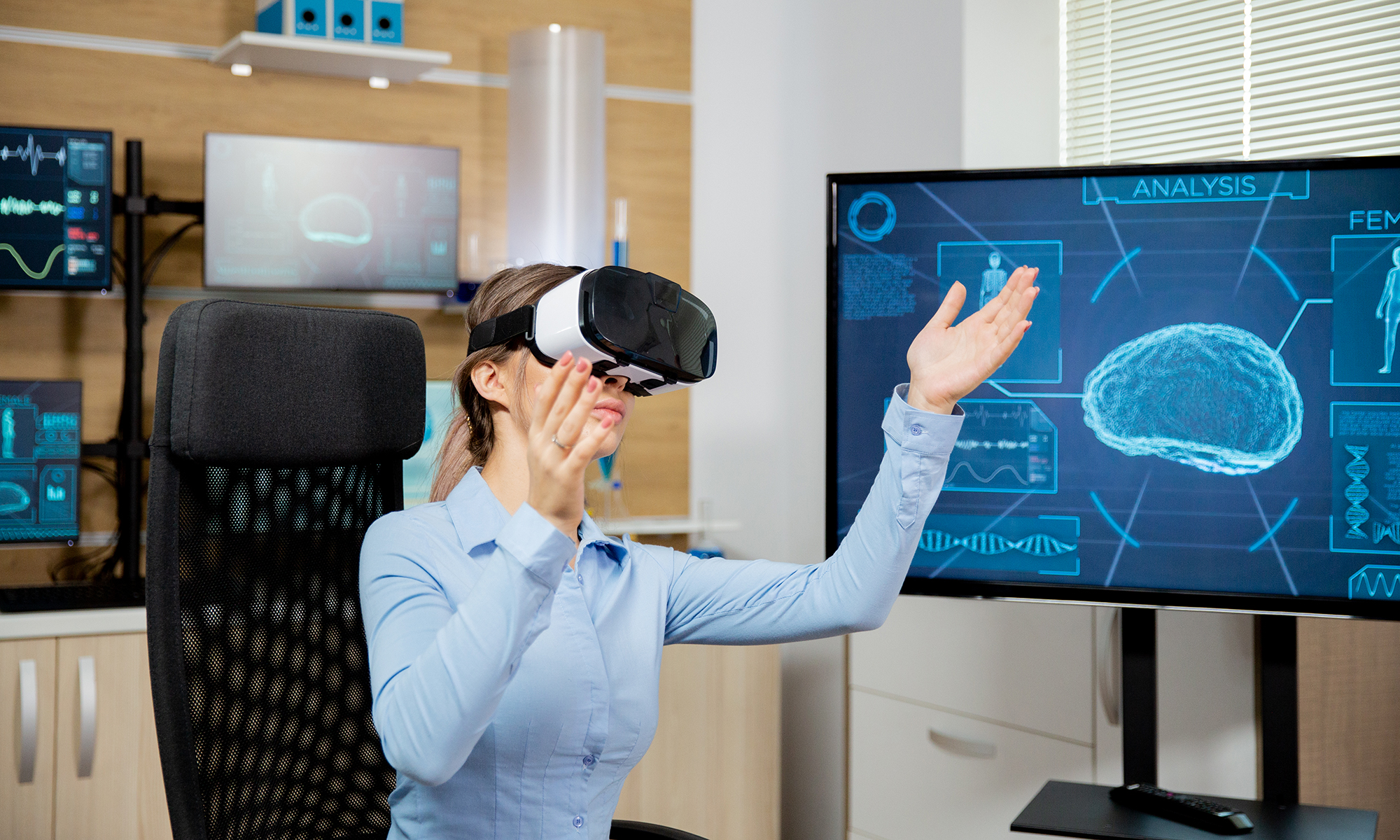
Cutting-edge technological advancements are revolutionizing the landscape of training and development. Embracing tools like virtual reality for employee training empowers learners to engage in hands-on experiences within safe environments. Immersive training programs enhance training outcomes and offer companies cost and time savings.
Integration of Artificial Intelligence and Machine Learning
Learning and development tools enhanced by artificial intelligence harness AI's adaptive machine learning capabilities to gather and analyze data on learners' preferences. This data is then utilized to tailor the training to meet their specific needs continuously. The high degree of personalization achievable through AI integration empowers learners to take charge of their skill development journey, allowing them to set their own goals, pace, and preferred learning style.
This not only enhances employee engagement but also boosts completion rates. Additionally, AI-driven solutions have profound implications for neurodivergent individuals who may struggle with conventional learning methods, especially in retaining auditory and written information. Moreover, AI has significantly improved the accessibility of training programs in various ways. For instance, Google's Automatic Captions Video App facilitates access to videos for deaf individuals by automatically generating captions in over 50 languages.
AI chatbots offer instant and efficient responses to common queries, ensuring uninterrupted learning experiences for users. Unlike humans, chatbots are available 24/7 and are free from limitations such as fatigue, forgetfulness, illness, or breaks. Well-designed chatbots engage learners through real-time interactions, providing instant access to relevant information and delivering prompt responses and appropriate follow-ups.
Immediate feedback provided by chatbots enhances learner comprehension, reinforces knowledge, and rectifies mistakes promptly. Research indicates that learners receiving immediate feedback tend to correct errors effectively and achieve higher scores than those receiving delayed or no input. Innovative tools, including digital tutors, leverage AI to provide continuous support, available 24/7. Apps like Duolingo utilize chatbot software to guide language learners effectively through their learning journey, showcasing the practical application of artificial intelligence in education.
Virtual Reality Training Applications
Virtual reality provides significant advantages for a wide range of employee training programs, particularly when selecting a technology tailored to specific training needs. VR is especially effective for the virtual practice of technical skills, such as data analysis or mastering complex workflows.
For training scenarios that require a high degree of immersion without real-world distractions, VR is the superior choice. This includes environments where employees need to develop or refine their soft skills. For example, VR can create realistic public speaking scenarios or complex problem-solving environments where participants can interact and engage deeply with the content.
In industries that demand a high level of spatial awareness and precise technical skills — like manufacturing, automotive, or aerospace — VR allows employees to practice in safe, controlled virtual settings that simulate high-risk tasks. This is crucial for understanding intricate processes without the immediate risks associated with physical environments.
It's also important to consider budget considerations, as the cost of VR solutions can vary based on the complexity and scope of the training required. Overall, VR stands out as a particularly effective tool for immersive training applications where deep engagement and focus are critical.
Choosing the Right VR Training Solution
Virtual Reality is revolutionizing learning and training across various industries, from construction and manufacturing to healthcare and language learning. If you are considering implementing VR training solutions in your business, here are essential tips to consider:
Clearly define your training objectives. Before investing in VR training solutions, define the specific skills and knowledge you aim to develop and the desired learning outcomes. This clarity will guide you in selecting the most suitable VR training solutions and designing effective training programs.
Choose the appropriate hardware and software. VR training requires specific hardware, including headsets, controllers, and powerful computers with compatible graphics cards. Select VR software that aligns with your training needs and budget, ensuring seamless delivery of training content.
Design engaging and interactive training content. Create immersive scenarios that simulate real-life situations relevant to employees' roles. Incorporate gamification elements such as points and rewards to enhance engagement and motivation throughout the training process.
Provide comprehensive training and support. Offer training sessions to familiarize employees with VR hardware and software. Provide access to user manuals and troubleshooting guides to assist employees in resolving any technical issues they encounter during training.
Measure training effectiveness. Evaluate the success of VR training by measuring metrics such as completion rates, engagement levels, and performance improvements. Gather employee feedback to identify improvement areas and refine training programs accordingly.
Best Virtual Reality Training Solutions with Program-Ace
Elevate your industry presence with Program-Ace, your professional software development services provider specializing in cutting-edge virtual reality training solutions. With our extensive expertise, your project will transcend conventional boundaries, offering immersive experiences that captivate and engage your audience — choosing Program-Ace as your partner means collaborating with a team renowned for overcoming complex technical challenges in the VR industry.
Our skilled professionals are well-versed in the latest VR development tools and methodologies, ensuring a smooth transition from concept to a fully functional VR application. Having delivered numerous successful VR projects across various industries, Program-Ace promises innovation and provides tangible results, turning your vision into a practical and operational reality. Reach out to us today for a partnership that empowers your objectives with unparalleled VR simulators. Let's shape the future together.

